Project 6.3 The Golden Ratio
Draw a square ABCD of side 2 cm. With M, the midpoint of AB,
as a centre and radius MD, draw an arc to meet AB extended
at E. Construct the rectangle AEFD; and then erase the
construction lines.
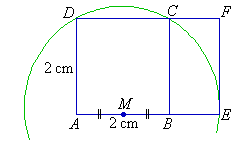
The rectangle thus obtained is called a golden rectangle; and is
often used in buildings and paintings.
1. Use Pythagoras' Theorem to find:
a. MC
b. MD
2. Find the length of the following line segments:
a. ME
b. AE
c. MF
d. AF

4. Use a calculator to find the golden ratio correct to 4 decimal
places.
Extension

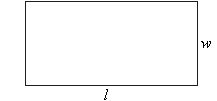
The number 1.618 is called the golden number.
5.
a. Draw a rectangle ABCD with AB = 89 mm and BC
= 55 mm.
b. Is ABCD a golden rectangle? Justify your
answer.
c. Construct a series of squares as shown in the following diagram;
and verify that each remaining rectangle is a golden one.
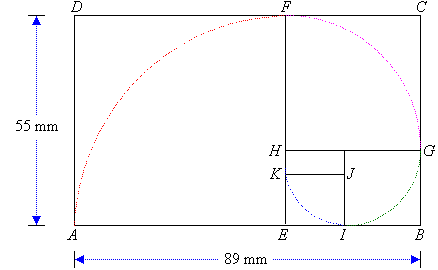
Golden Spiral
6. With centre E and radius EA draw an arc from A to F. With centre H and radius HF draw an arc from F to G; and continue this process as far as possible.
The spiral thus obtained is called the golden spiral and occurs
often in nature.
Your report should include all of your working and diagrams.
Project 6.4 Spirals
If a point moves continually clockwise (or anticlockwise) about and at
an increasing distance from a central point, then the path traced out is
said to be a spiral.
Archimedes, the Greek mathematician, discovered the spiral known as the Spiral of Archimedes.
1.
a. Draw a series of 12 radiating lines 30º apart.
b. Make a point 3 mm from the centre on one of the lines.
c. Move in an anticlockwise direction to the next radiating line and
mark a point 6 mm from the centre.
d. Keep moving to successive lines and increasing the distance from
the central point by 3 mm each time.
e. Join the points by a smooth curve; and erase the construction (i.e.
dotted) lines.
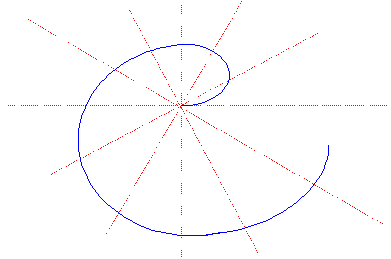
The curve thus obtained is the Spiral of Archimedes.
Extension
2.
a. Draw a Spiral of Archimedes which has radiating lines 10º
apart by moving only 2 mm more from the centre along the next radiating
line in an anticlockwise direction.
b. How do the characteristics of the second spiral differ from the
characteristics of the first spiral drawn?
René Descartes, the French mathematician,
discovered the equiangular spiral which approximates the spiral in
nautilus shells and other shells of cephalopods.
3.
a. Draw a dotted circle of radius 2.2 cm.
b. Draw a series of 12 radiating lines 30º apart.
c. Select a point on the circle where it meets a radius; and drop a
perpendicular line from the next radius in an anticlockwise direction to
this point.
d. From a point on the third radius, drop a perpendicular line to
meet the first perpendicular line drawn.
e. Continue this process as long as you can (i.e. until you reach
the central point).
f. Erase the construction lines. The curve thus obtained is an equiangular
spiral.
g. Where does the equiangular spiral terminate?
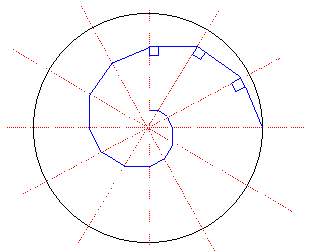
4.
a. Draw an equiangular spiral, which has radiating lines 20º
apart.
b. How do the features of the second spiral differ from the features
of the first spiral drawn?
5. Compare the characteristics of the Spiral of Archimedes and the
equiangular spiral.
Your report should include all of your working and diagrams. |